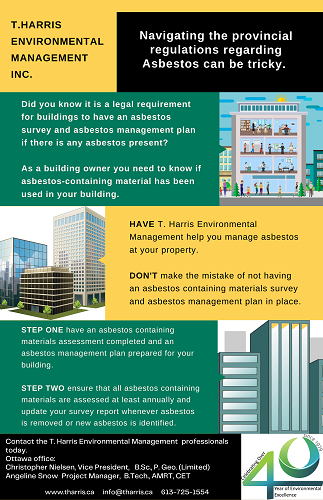 Sunday, May 19, 2024
Sunday, May 19, 2024  Sunday, May 19, 2024
Sunday, May 19, 2024 
by Christopher Nielsen, B.Sc., P. Geo. (Limited), Vice President T. Harris Environmental Management Inc.
Hazardous materials take a bite our of renovation and demolition projects, but employing the proper equipment and strategies creates a sound defence, which we all know is the best offense.
Tighter standards for hazardous materials in buildings mean that anyone involved in renovation or demolition needs to become better at managing the issue. While much of the focus has been on asbestos contamination, there is also the need to manage the lead often found in older types of pain and in sound-dampening and x-ray protective application, mercury from thermostats and fluorescent light fixtures, and other materials such as PCBs that may be found in electrical equipment.
Fortunately, even as requirements go up, there are advances in information technology that helps make compliance easier.
To get an idea of the current state of hazardous-materials management issues and solutions, consider the case of asbestos.
This group of fire-retardant substances, once considered a wonder material, was used with enthusiasm for everything from floor-levelling compound to ceiling tiles. Almost any building in Canada constructed before 1985 contains some asbestos. It is even still being used today in some applications. However, it is now associated with a wide range of diseases which are typically incurable, often lethal, and many of them long latency periods so the full effects are now only appearing. For example, it is now estimated that one form of asbestos-induced cancer, mesothelioma, which as no cure, will become an epidemic in the industrialized world in about 10 to 20 years.
Better understanding of the threat posed by asbestos means that provinces have put in place new regulations on asbestos handling that have big implications for construction projects involving existing buildings. Most of these regulations change the definition of “asbestos-containing material” and raises requirements on how it is handled.
Most provinces have expanded the range of asbestos materials that must now be identified, documented and maintained. In many cases, the percentage of asbestos in material which triggers the need for special handling is lower.
For members of the construction sector, this is likely to result in more need to invest in training and personal protective equipment (PPE), and greater reliance on asbestos-remediation consultants and specialist contractors.
Those who fail to change with the new environment may find work at their sites slowed or stopped by inspectors, union leaders and employees who discover suspect asbestos-containing materials that have not been identified in building assessments. Such situations may have significant negative impacts for forepersons, supervisors, management and company owners and directors who are shown to have failed in their obligation to provide a safe work environment.
Renovation is particularly challenging in public-sector buildings. In part, this is because of their size. While it is relatively simple to find and remove the asbestos in an open warehouse, asbestos remediation in a school, hospital or government building must often be done in stages because the primary building operations cannot be shut down. This means a painstaking process of relocating the building’s users out of an area to be purged of asbestos and sealing it off to avoid contaminating other parts of the building. In a heavily-unionized environment such as the public sector, this work must be done in a way that is verifiable to labour organizers.
The solution to hazardous materials management is a multipronged approach, with all elements working in concert.
Providing the right skills is one of the first lines of defence when it comes to contaminated worksites. In the case of asbestos, even seasoned construction industry members are surprised at the sheer range of products that contain this material. As well as ceiling tiles and asbestos cement, asbestos may be found in over 3,000 products and construction materials which can range from drywall filler to window sealers.
In many cases, training needs to focus on knowing what materials might contain asbestos, recognizing the material when it is encountered, and calling in the right expertise in the form of consultants and asbestos-remediation specialists. The same goes for mercury, lead and other contaminants. Many workers and supervisors need more training in the us of PPE and about what level of protection is needed in what circumstances.
As in any area of business, getting professional advice on how to assess and manage asbestos in your facilities is a must. Regulatory requirements around asbestos identification and management vary slightly in each province and under Federal guidelines, but the minimum requirement of knowing if you have any asbestos in your buildings is universal.
Construction companies, building managers and owners can use the information provided to demonstrate to employees, organized-labour representatives, regulators and other stakeholders that building contaminants are effectively managed.
Don’t let concerns over asbestos keep you up at night. With the right advice, asbestos management can be dealt with easily.
Christopher Nielsen, B.Sc., P. Geo. (Limited), Vice President T. Harris Environmental Management Inc. Christopher has over 30 plus years in the environmental management sector.